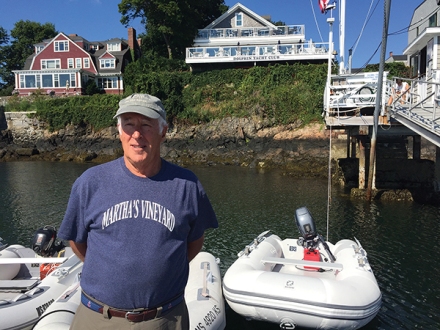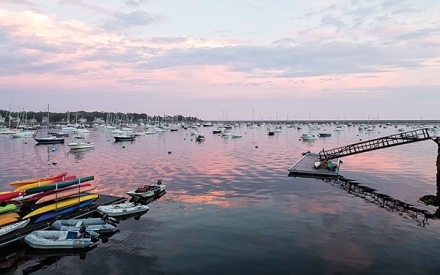By Shelley A. Sackett

George Freedman of Marblehead reflected on the history of the Dolphin Yacht Club. Photo by Steven A. Rosenberg/Journal Staff
MARBLEHEAD – John Smidt was a kid from Marblehead who loved sailing and being around the harbor. His dad, Phenny, bought a boat in 1948 and John remembers they joined the Salem Willows Yacht Club, even though his hometown harbor was miles closer.
“The way the story has been passed down, there was no place in Marblehead Harbor for a Jew with a boat,” John said over coffee and a muffin at an outdoor café on a recent sunny morning. “I didn’t know the politics of what was going on, but I watched what was happening.”
Although there was no written ban, realtors steered Jewish buyers away from Marblehead. “‘You probably wouldn’t be comfortable here’ was the phrase most commonly used,” said retired psychiatrist George Freedman, who grew up in Marblehead.
That discrimination extended to Marblehead Harbor and its yacht clubs, which in 1950 denied fuel, mooring, or launch service to Jewish boaters. Like Phenny Smidt, they either joined clubs in nearby harbors or had to moor at a spot unaffiliated with any of the Marblehead clubs.
Fed up with the status quo, a group of Jewish boaters decided to take matters into their own hands. In January 1950, 14 men formed the Dolphin Yacht Club and sent letters soliciting charter members “with the main qualification being a desire to participate in nautical activity as an avocation.” The stated purpose and scope of the club was to “promote and foster the nautical spirit among its members regardless of color, race, or creed.” Initial membership would be limited to 60.

The founding members of Marblehead’s Dolphin Yacht Club in 1950.
The list of founding members and tentative officers who signed the letter included Harry Weinstein, B. Frederick Yoffa, Morris Jaynes, Ben Myers, Arthur Rubino, Phenny Smidt, Irving Mann, Leo Sonnabend, Dr. Adolph Sandberg, Harry Simon, Nathan Cohen, Dr. Nathan Silbert, Hy Jaffee, and John Rimer.
Nine attended the club’s first breakfast meeting on January 15 at Lynn’s Hotel Edison, according to a $12.65 bill that itemized breakfast charges at 85 cents each and room rental at $5.
Smidt remembers going with his father to the Dolphin Yacht Club’s first location, a space under the Rockmere Hotel (now Glover Landing condos) with a gravel floor and metal lockers. Boaters would grab their dinghies and row out to their moorings.
In 1955, the Marblehead Harbor Yacht Club, adjacent to the Rockmere Hotel, merged with another club and its property became available. Lewis Athanas, brother of restauranteur Anthony Athanas, offered to act as a non-Jewish “straw” – or third party – to buy the Marblehead
Harbor Yacht Club and turn it over to the Dolphin Yacht Club. “He was just open-minded,” Smidt said. “Looking back, it took guts.”
Over the next six decades, the club fluctuated in its financial solvency, physical amenities, and members, but remained steadfast in its promise to be an inclusive presence on the previously exclusive Marblehead Harbor.
In 1964, 22-year-old John Smidt bought his first sailboat, a 16-foot Bullseye, and joined the Dolphin. By 1969, he and Marvin Frank put the club on the yachting map when they raced Frank’s boat, “Bat Yom,” in the 70-hour Marblehead to Halifax race, becoming the first Dolphin boat to compete in that prestigious event.

The Dolphin Yacht Club looks out onto Marblehead Harbor. Photo courtesy of dolphinyachtclub.com
By 1973, the club needed more income to remain solvent. Smidt tried to beef up membership numbers – and the club’s finances – by advertising the Dolphin as “a yacht club for all people.” He did the same thing in 1980 when membership had dwindled to 45. By the end of that season, the Dolphin had 75 members who represented a mixture of people and cultures.
“We took on a bunch of non-Jewish members,” Smidt said. But the club still struggled to make ends meet.
The situation was so dire that a 1986 article in the Jewish Journal was titled, “The Dolphin sends an S.O.S. to the Jewish community.” Marblehead pharmacist Elliot Strasnick, a member since 1975, dug in his heels, enlisted volunteers like Freedman, and “decided to go for it. We started to think outside the box,” he said. The club sold bonds, paid off its debts, and rebooted with more emphasis on social and kayak memberships and amenities.
Next, the club procured a liquor license, started offering food service, and offered social memberships. Today, social memberships far outnumber boaters, and non-Jews outnumber Jews. The club recently completed extensive renovations and hired Alan Knight, former executive chef at the Boston Yacht Club. On sunny weekends, dinner reservations on the deck are hard to get.
Despite the larger numbers and fancier digs, Freedman still feels the small club friendliness of the early years. But more than that, the 2017 Dolphin has come full circle, more closely fulfilling the original members’ intent.
“Although the club’s origins are Jewish, its original charter specifically stated that the club was open to all,” Freedman said. “Fortunately, we have lost the perception of being “the Jewish Club,” but the history is important, especially in these sensitive times.”
Interesting untold history. Stan
LikeLike
My Grandfather was friendly with most of those guys. In fact Leo Sonnabend was their insurance agent. ( We still use the same firm today. The Sonnabend family also started Sonesta hotel. It was named after their mother Ester. My Grandparents built a home in Swampscott. In 1948 approx. Lots of Jewish families on the same street. I did have a 1960’s incident at the one of the other Clubs because I was Jewish.
Proud to be a member of Dolphin. A great place.
LikeLike